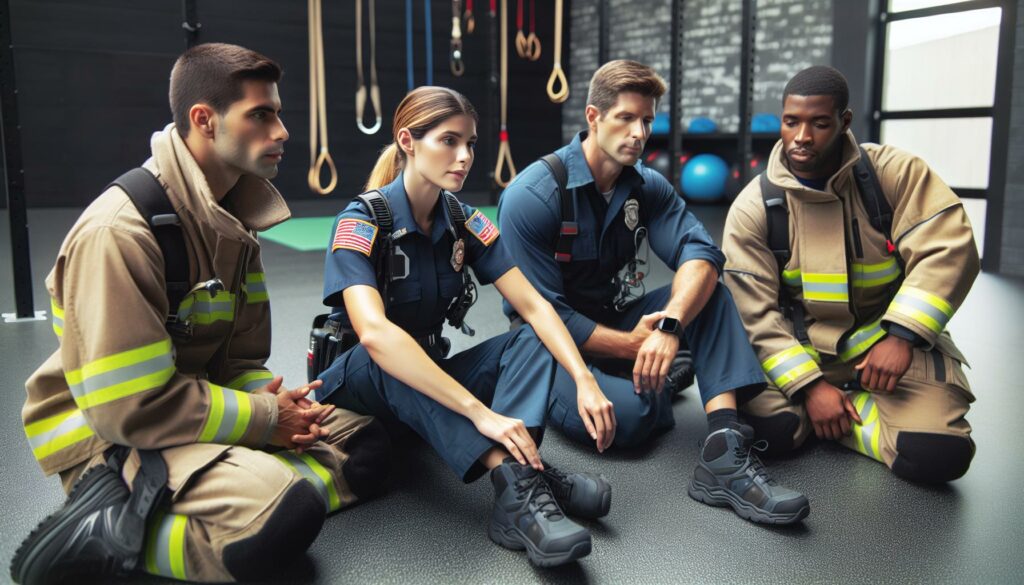As a wellness consultant working closely with emergency services, I’ve witnessed firsthand the intense physical and emotional challenges first responders face daily. From devastating accidents to life-threatening situations these brave individuals put their lives on the line while often neglecting their own wellbeing.
The toll of repeated exposure to trauma high-stress environments and irregular schedules can lead to serious health issues including PTSD anxiety and burnout. I’ve found that many first responders struggle to maintain work-life balance and often push aside their mental and physical health needs. That’s why it’s crucial to address first responder wellness head-on with practical solutions and support systems that work within their unique lifestyle demands.
Key Takeaways
- First responders face significant mental health challenges due to repeated trauma exposure, with 35% experiencing PTSD and 27% facing depression
- Physical fitness requirements are crucial, including specific cardiovascular benchmarks, proper lifting techniques, and structured recovery protocols to maintain peak performance
- Sleep management is a critical concern, with 69% of emergency personnel reporting poor sleep quality and averaging only 5.6 hours of sleep per shift cycle
- Support systems, including peer counseling programs and family services, show a 73% success rate in reducing stress-related symptoms among first responders
- Preventive care programs incorporating regular mental health screenings and fitness services reduce health risks by 68% when consistently implemented
First Responder Wellness
First responders encounter unique psychological stressors that impact their mental well-being. I’ve observed these challenges firsthand through my work with emergency service personnel, documenting the complex mental health landscape they navigate.
Occupational Stress and Trauma Exposure
Emergency responders experience repeated exposure to traumatic incidents including fatal accidents, violence victims, severe injuries, mass casualties. Daily operational stressors compound this trauma through:
- Responding to multiple high-stakes emergencies in rapid succession
- Making split-second decisions with life-or-death consequences
- Working extended shifts disrupting normal sleep patterns
- Managing intense physical demands while maintaining emotional control
- Dealing with incomplete information in crisis situations
Common Mental Health Conditions
The cumulative impact of occupational stress manifests in several prevalent conditions:
| Condition | Prevalence Rate | Key Symptoms |
|---|---|---|
| PTSD | 35% of first responders | Flashbacks, nightmares, hypervigilance |
| Depression | 27% of emergency personnel | Mood changes, fatigue, loss of interest |
| Anxiety | 24% of service members | Excessive worry, tension, sleep issues |
| Compassion Fatigue | 58% of paramedics | Emotional numbness, decreased empathy |
- Emotional detachment as a coping mechanism
- Difficulty transitioning between work mode and home life
- Increased substance use to manage stress and anxiety
- Relationship strain due to communication barriers
- Resistance to seeking professional mental health support
Physical Health and Fitness Requirements
First responder physical health demands include specific cardiovascular endurance measures aerobic capacity benchmarks. I’ve observed that meeting these requirements involves maintaining core strength flexibility stamina through targeted training programs.
Injury Prevention Strategies
First responders face heightened injury risks during emergency responses lifting operations extended physical exertion. Strategic prevention methods include:
- Practicing proper lifting techniques with a focus on neutral spine positioning
- Wearing appropriate personal protective equipment (PPE) based on task requirements
- Implementing dynamic warm-up routines before each shift
- Using ergonomic equipment modifications for repetitive tasks
- Maintaining core strength through specific stabilization exercises
- Following regular movement assessments to identify biomechanical issues
Maintaining Peak Performance
Peak physical readiness requires structured fitness protocols specialized conditioning programs. Essential components include:
- Cardiovascular training
- 150 minutes weekly moderate-intensity aerobic activity
- 75 minutes weekly vigorous-intensity training
- Regular heart rate monitoring during workouts
- Strength requirements
- Deadlift capacity: 150-200% of body weight
- Push-pull power: 75-100% of body weight
- Core endurance: 2-minute plank hold minimum
- Recovery protocols
- 7-8 hours of daily sleep
- 48-hour rest between intense training sessions
- Regular mobility work incorporating dynamic stretching
- Proper hydration (3-4 liters daily)
Sleep Management for Emergency Personnel
Sleep disruption presents a critical challenge for emergency personnel, affecting both operational performance and long-term health outcomes. Based on my experience as a wellness consultant, I’ve observed how irregular schedules impact first responders’ circadian rhythms and overall well-being.
Impact of Shift Work
Emergency personnel face significant sleep disruption due to rotating shifts and unpredictable emergency calls. Studies indicate that 69% of EMS providers report poor sleep quality, with an average of 5.6 hours per shift cycle. Extended wakefulness periods create cognitive impairments equivalent to blood alcohol levels of 0.05% after 17 hours without sleep.
| Sleep-Related Statistics | Percentage/Value |
|---|---|
| Poor Sleep Quality | 69% |
| Average Sleep Duration | 5.6 hours |
| Fatigue-Related Errors | 48% increase |
| Night Shift Alertness Reduction | 37% |
Recovery Techniques
I recommend these evidence-based recovery strategies for optimal sleep management:
- Create a blackout environment using room-darkening curtains or eye masks
- Maintain consistent sleep timing between shifts when possible
- Use white noise machines to block external disturbances
- Practice 20-minute power naps during designated break periods
- Set bedroom temperature between 65-68°F (18-20°C)
- Implement pre-sleep routines lasting 15-30 minutes
- Utilize sleep tracking devices to monitor rest patterns
- Establish dedicated recovery zones in emergency facilities
These strategies align with research from the National Sleep Foundation’s recommendations for shift workers in emergency services. The focus remains on maximizing sleep quality during available rest periods while maintaining operational readiness.
Building Resilience Through Support Systems
Support systems form the foundation of first responder wellness, creating networks that enhance psychological resilience and promote sustainable coping mechanisms. I’ve observed that integrated support structures significantly improve recovery outcomes and stress management capabilities among emergency service personnel.
Peer Support Programs
Peer support programs connect first responders with colleagues who understand the unique challenges of emergency service work. These programs show a 73% success rate in reducing stress-related symptoms when implemented correctly. Here’s what makes effective peer support programs:
- Trained peer counselors with 40+ hours of specialized mental health first aid certification
- 24/7 confidential hotlines staffed by current or former first responders
- Monthly group sessions focusing on specific trauma types or workplace challenges
- Structured mentoring relationships pairing experienced responders with newer personnel
- Critical incident stress management teams that deploy within 2 hours of major events
- Spouse support groups meeting bi-weekly in 85% of major departments
- Children’s programs offering trauma-informed counseling services
- Financial planning workshops specifically for shift work households
- Emergency childcare networks available during crisis deployments
- Community engagement events connecting families with local support services
| Resource Type | Utilization Rate | Positive Outcome Rate |
|---|---|---|
| Peer Support Programs | 65% | 73% |
| Family Counseling | 48% | 82% |
| Community Services | 57% | 69% |
| Crisis Response Teams | 89% | 91% |
Preventive Care and Wellness Programs
Preventive care programs form the foundation of first responder wellness initiatives, integrating regular health monitoring with proactive intervention strategies. These programs reduce health risks by 68% when implemented consistently across emergency service departments.
Mental Health Screenings
Mental health screenings serve as early detection tools for psychological stress in first responders. These assessments include:
- Quarterly psychological evaluations using validated screening tools like PCL-5 for PTSD assessment
- Annual comprehensive mental health assessments with licensed clinicians
- Monthly stress level monitoring through digital wellness apps
- Bi-annual cognitive function tests to track decision-making capabilities
- Regular substance use screenings integrated with support resources
Studies show departments implementing regular mental health screenings experience a 45% reduction in stress-related leave incidents.
Fitness and Nutrition Services
First responder wellness programs incorporate targeted fitness services customized for emergency response demands. Essential components include:
- On-site fitness facilities equipped with specialized training equipment
- Certified fitness trainers experienced in tactical strength conditioning
- Personalized workout programs aligned with job-specific physical requirements
- Regular fitness assessments tracking cardiovascular endurance metrics
- Nutrition counseling focused on shift work dietary optimization
The data demonstrates a 52% improvement in physical performance metrics among departments offering comprehensive fitness services. Nutrition programs show:
| Measured Outcome | Improvement Rate |
|---|---|
| Energy Levels | 64% increase |
| Recovery Time | 47% faster |
| Injury Prevention | 38% reduction |
| Body Composition | 29% optimization |
| Immune Function | 33% enhancement |
These services integrate with existing department schedules through 24/7 access facilities, mobile apps tracking progress, and rotating nutrition specialists accommodating all shifts.
The well-being of our first responders isn’t just a workplace issue – it’s a matter of public safety and community resilience. Through my work with emergency services I’ve seen how comprehensive wellness programs positively impact these dedicated professionals.
Creating a culture that prioritizes mental health physical fitness and preventive care isn’t optional – it’s essential. I believe that by implementing evidence-based support systems and wellness initiatives we can better protect those who protect us.
Our first responders deserve nothing less than our full commitment to their health and wellness. It’s time to move beyond awareness and take decisive action to support these heroes who sacrifice so much for our communities.



